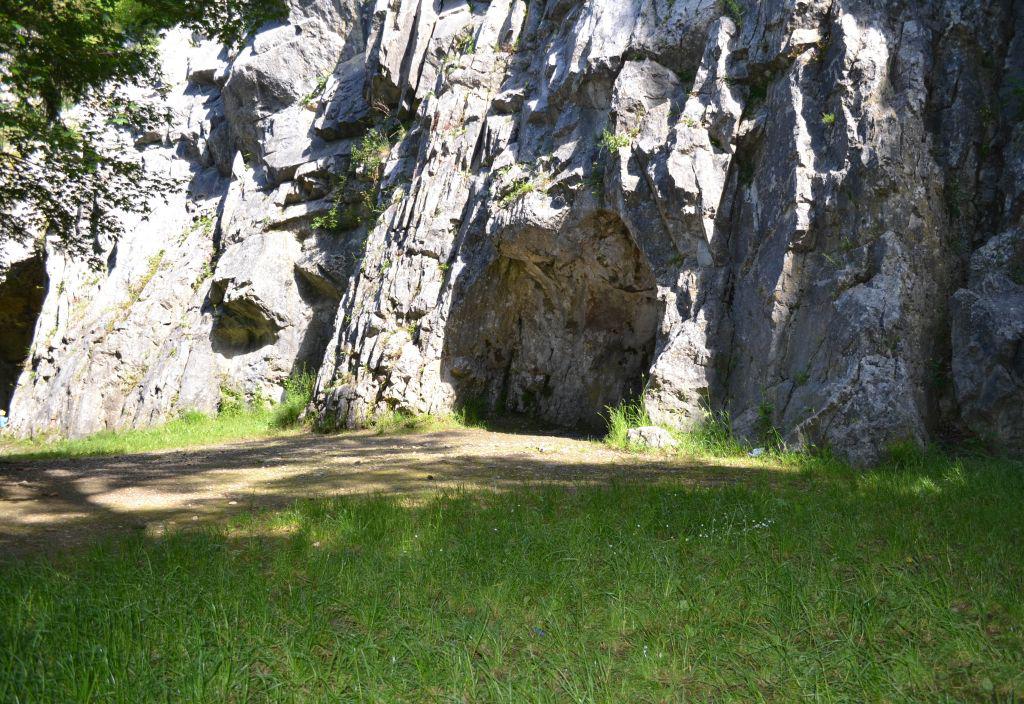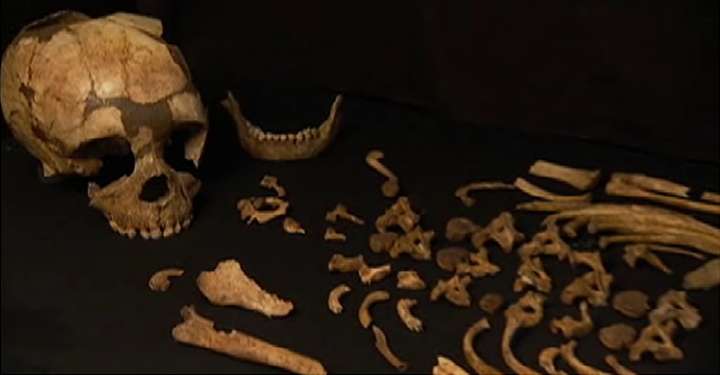|
|
Post by Admin on Dec 26, 2016 20:26:23 GMT
 Neanderthals may have taken vacations, or at least they liked the view from the granite cliffs of Jersey. New evidence suggests Neanderthals visited La Cotte de St Brelade, a prehistoric site on the island of Jersey, for at least 180,000 years. Previous surveys of La Cotte de St Brelade have been limited in scope, focused mostly on concentrations of mammoth remains within the cave. The latest effort involved a wide-angle approach.  Researchers re-examined stone artifacts unearthed in the 1970s to better understand how they were made and where materials were sourced from. The survey helped archaeologists get a better sense of how visitors to La Cotte de St Brelade utilized local resources and the surrounding landscape. The analysis also revealed where Neanderthals were visiting from. Jersey is an island in the English Channel off the coast of Normandy, France, but it wasn't always surrounded by water. Some 180,000 years ago, expanding ice caps captured sea water, shrinking sea levels and exposing large swaths of offshore resources -- land now underwater.  Lead author Dr Andy Shaw of the Centre for the Archaeology of Human Origins (CAHO) at the University of Southampton said: “La Cotte seems to have been a special place for Neanderthals. They kept making deliberate journeys to reach the site over many, many generations. We can use the stone tools they left behind to map how they were moving through landscapes, which are now beneath the English Channel. 180,000 years ago, as ice caps expanded and temperatures plummeted, they would have been exploiting a huge offshore area, inaccessible to us today.” Previous research focussed on particular levels in the site where mammoth bones are concentrated, but this new study took a longer-term perspective, looking at how Neanderthals used it and explored the surrounding landscape for over 100,000 years.  The team, including academics from the British Museum, University College London (UCL) and the University of Wales found that Neanderthals kept coming back to this particular place, despite globally significant changes in climate and landscape. During glacial phases (Ice Ages), they travelled to the site over cold, open landscapes, now submerged under the sea. They kept visiting as the climate warmed up and Jersey became a striking highpoint in a wide coastal plain connected to France. |
|
|
|
Post by Admin on Jan 1, 2017 20:19:16 GMT
 Neanderthal genome to identify their genes among ours. When modern humans left Africa about 50,000 to 80,000 years ago and spread through Europe and Asia, they interbred with Neanderthals. The first hybrid offspring would have been, on average, a 50-50 mix of modern human and Neanderthal genes, and could then have themselves bred with modern humans, Neanderthals or other hybrids. So what happened to the Neanderthal DNA? Today, Neanderthal genes are a few percent of the genome of people of European ancestry, a little more common in people of East Asian descent, and almost absent in people of African ancestry.  Coop and postdoctoral researchers Ivan Juric and Simon Aeschbacher devised methods to measure the degree of natural selection acting on Neanderthal DNA in the human genome. One hypothesis has been that Neanderthals quickly became genetically incompatible with modern humans, so their hybrid offspring were not "fit" in evolutionary terms - they either failed to thrive or were not fertile. The researchers found something different. Rather than showing strong selection against a few Neanderthal genes, they found weak, but widespread selection against many Neanderthal DNA sequences that is slowly removing it from our genome.  Coop said that's consistent with a small, isolated population of Neanderthals mixing with a much larger population of modern humans. Inbreeding in small populations means that genetic variants can remain common even if they're harmful to some degree. But when they mix into a larger population, natural selection starts to act against those variants and weed them out. "The human population size has historically been much larger, and this is important since selection is more efficient at removing deleterious variants in large populations," Juric said. "Weakly deleterious variants that could persist in Neanderthals could not persist in humans. We think that this simple explanation can account for the pattern of Neanderthal ancestry that we see today along the genome of modern humans." |
|
|
|
Post by Admin on Jan 5, 2017 20:29:10 GMT
 Evidence found in Goyet, Belgium, suggests Neanderthals feasted on each other around 40,000 years ago. Human bones from a newborn, a child and four adults show clear signs of cutting to extract the marrow within, experts said.  Belgian archaeologist Christian Casseyas said: "It is irrefutable, cannibalism was practised here." The bones date from when Neanderthals were nearing the end of their time on Earth before being replaced by our direct ancestors, the Homo sapiens.  They show traces of cutting “to disarticulate and remove the flesh,” said Christian Casseyas, who also leads tours for the public at the caves. Neanderthals “broke these bones in the same way that they broke those of the reindeer and horses found at the entrance of the cave, certainly to extract the marrow”, he added. |
|
|
|
Post by Admin on Jan 7, 2017 20:24:32 GMT
 Neandertal funerary practices remain at the forefront of palaeoanthropological research, generating heated debates following the revision of old data and new excavations at key sites such as La Chapelle-aux-Saints1,2, Roc de Marsal3, Saint-Césaire4 and La Ferrassie5. More generally, attention has focused on the variability of Neandertal mortuary practices to evaluate their cognitive and symbolic implications, especially as they may provide insights concerning the social systems of this fossil human group6. Neandertals are known to have buried their dead and are associated with mortuary behaviours that are often difficult to interpret in Palaeolithic contexts. The site of Krapina (Croatia) is an instructive example in this sense. Evidence for cannibalism was first proposed for this site as early as 19017 based on the fragmentation and traces of burning from a large collection of early Neandertal remains. This evidence has since been disputed by proponents of alternative explanations for the human bone modifications who argue for natural processes while others maintain that the anthropogenic manipulations are best interpreted in the context of secondary burials8. Several studies dedicated to cannibalism have proposed that securely identifying anthropogenic modifications related to this practice should incorporate evidence for the similar treatment of both faunal and human remains in the interest of extracting nutrients9,10,11. In addition to Gran Dolina (level TD6; Early Pleistocene) in Spain, which has produced the earliest undisputed evidence for cannibalism12, further examples have also been documented at several Western European Neandertal sites, including El Sidrón and Zafarraya13,14 in Spain, and Moula-Guercy and Les Pradelles15,16 in France.  Here we provide new data on the diversity of Neandertal mortuary behaviour, focusing on a small area of their known range, Northern Europe, during Marine Isotope Stage (MIS) 3 (ca. 60–30 thousand years ago), in order to identify small-scale processes during this short period that witnessed the disappearance of the Neandertals17. We present 99 new Neandertal remains recently identified among the collections from the Troisième caverne of Goyet (Belgium), some of which exhibit anthropogenic modifications, and discuss their implications.  The Troisième caverne (or “Third cave”) of Goyet, excavated in the latter half of the 19th and beginning of the 20th century, and again at the end of the 1990s18, is part of a large cave system located in the Mosan Basin (Supplementary Fig. S1). The most extensive excavations were carried out by Edouard Dupont in 1868, who described five “fauna-bearing levels” (FBL; ref. 19; Supplementary Note S1). The Troisième caverne yielded a rich archaeological sequence with Middle and Upper Palaeolithic deposits containing Mousterian, Lincombian-Ranisian-Jerzmanowician (LRJ), Aurignacian, Gravettian and Magdalenian artefacts as well as Neolithic and historic period material20,21,22,23. Whether the Mousterian material derives from a single or multiple phases of occupation is currently impossible to discern (Supplementary Note S2). Unfortunately, the excavation methods did not meet today’s standards, and it appears that the levels described by Dupont actually represent a mix of material from different periods (e.g., ref. 24).  Several human remains from different levels were published by Dupont19 and Hamy25, although only a few figure in the Catalogue of Fossil Hominids26, all of which were attributed to the Magdalenian. In 2004, we identified both a Neandertal mandible fragment and an isolated tooth among the human material recovered by Dupont from the Troisième caverne and currently housed at the Royal Belgian Institute of Natural Sciences (RBINS)27, making Goyet one of the few Northern European sites north of 50° N to have yielded MIS 3 Neandertal remains (Supplementary Note S1 and Supplementary Fig. S1). |
|
|
|
Post by Admin on Jan 9, 2017 20:30:54 GMT
 Figure 1: Neandertal remains from the Troisième caverne of Goyet (Belgium). Identification of new Neandertal remains at Goyet and their biogeochemical characterization The reanalysis of the Goyet material comprised (i) the revision of the human skeletal material, (ii) systematic sorting of the faunal collections to check for unidentified human remains (Supplementary Fig. S2), and (iii) a multidisciplinary study of the human remains and their context. Two-hundred and eighty three human remains were identified from different periods, including 96 bone specimens and three isolated teeth identifiable as Neandertal (Supplementary Table S1 and Supplementary Notes S3, S4 and S5). A good number (n = 47) of the bone specimens refit, reducing the total number of isolated Neandertal remains to 64 (Fig. 1 and Supplementary Table S2), of which 10 were directly radiocarbon (14C) dated, 15 were sampled for stable isotope analyses, and 10 for DNA extraction (Table 1 and Supplementary Table S3). Based on their morphology and morphometric characteristics, developmental stage and side for paired elements, as well as the successful recovery of endogenous mitochondrial DNA (mtDNA) sequences, the minimum number of individuals (MNI) represented by the Goyet sample is estimated at five (four adolescents/adults and one child represented by a single tooth; Supplementary Note S5 and Supplementary Fig. S3). Although the Neandertal sample includes cranial and postcranial elements (Fig. 1), with long bones best represented and extremities mostly absent, the minimum number of elements (MNE = 35) demonstrates a very low overall skeletal representation. The best represented elements are, in decreasing order, the tibia (six of the eight tibias expected for four adolescents/adults, 75% representation), femur and cranium (50%), humerus and mandible (25%; Supplementary Table S4). Out of the 10 samples processed for genetic analysis, seven show three distinct complete or almost complete mtDNA lineages (noted 1–3 in Table 1). The newly reconstructed mtDNAs from Goyet were compared with the mtDNA of 54 modern humans, eight previously sequenced Neandertals and one Denisovan individual29,30,31,32,33,34. Phylogenetic relationships were assessed using maximum parsimony and maximum likelihood trees (Fig. 2 and Supplementary Fig. S4), confirming the analysed specimens to fall within the known diversity of Neandertal mtDNA. The Goyet Neandertal mtDNAs appear most closely related to late Neandertal mtDNAs from Central and Western Europe, such as those from the Neandertal type-site (Germany), El Sidrón (Spain) and Vindija (Croatia), which all show only modest genetic variation despite large geographic distances when compared to modern humans. As previously suggested31, this might reflect a low effective population size of Neandertals in general, and for the late Neandertals in particular.  Figure 2: Maximum parsimony tree for the seven analysed Goyet samples that produced complete or almost complete mitochondrial genomes compared to 63 published modern human, Neandertal and Denisovan mtDNAs. |
|
















